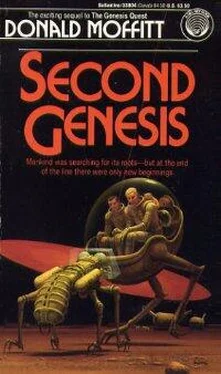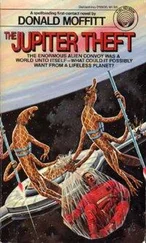They stood around, conferring with twitching movements of their long sterns. Bram saw little, discreet flashes of lights from their helmets and assumed it was the polarized light version of radio communication. After getting everything settled to their apparent satisfaction, they slung equipment over their humped shoulders—or hips, if that’s what they were—and began skittering down the long boulevard with lots of nervous, darting side trips, staying in a loose group.
People began to drift down from rooftops and emerge from side streets to trail after the insect-people at a respectful distance.
“We’d better get down there,” Bram said.
He vaulted over the rooftop and floated to the ground, with Jao close behind him. He strode in thirty-foot bounds across the plaza and caught up with the little parade going down the avenue.
Trouble started almost immediately. A skylarking fool who had been leaping up and down in great swoops shot fifty feet into the air and came down squarely in front of one of the insect-people. Apparently he got a good look at the jelly-eyed face within the helmet, because he backed away with a jerk and stumbled.
The insect-being showed no signs of-stopping, and the skylarker showed no signs of getting out of its way. Jao reached the spot in one long soaring arc and snatched the offending person out of the way with a hand hooked into the webbing of the life-support backpack.
He bore his kicking prize to Bram. He did not set the fellow down on ground, but held him out to Bram at arm’s length.
The face within the helmet was that of a junior archivist named—Bram rummaged in his memory—Alb something-or-other. Alb was less than thirty years old, having been born in the heart of the Milky Way, and hadn’t lived long enough to develop good sense.
“Put him down,” Bram said.
Instead of letting go, Jao rammed the errant archivist into the ground with some emphasis. Alb stood there with a silly grin on his face.
“Alb, I thought I told everybody—” Bram began.
“He can’t hear you,” Jao said. “He isn’t tuned in to your frequency.” He made twisting motions to get the idea across to Alb, but the young man just stood there stupidly, no doubt listening to the gibes of his own circle of friends.
“Oh, chaos take it!” Jao exclaimed. He dialed through his own frequencies till he hit Alb’s. He must have turned the power full up, to judge by the way Alb flinched. Somewhere out there a number of other people must have acquired an earache too. Jao proceeded to give the unfortunate fellow a dressing down. Bram tuned in for the tail end of it: “…brains of a three-legged baggage walker!”
Alb gave Bram a sheepish apology and promised to behave. Bram heard group laughter on the frequency, and Alb turned pink.
They caught up with the insect patrol some distance down the avenue of rubble. Jao’s lecture seemed to have had good effect; the trailing crowd of people was hanging back farther. One of those who wasn’t lagging behind was Heln Dunl-mak. She skipped ahead of the alien party, just beyond what she had described to Bram as the insect-people’s “avoidance zone.”
Heln’s slight figure was top-heavy with improvised equipment—a bulky pack that Jao had put together for her. It was flashing modulated polarized light, some of it drawn from frequently appearing patterns in the stick-ship’s early radio transmissions, some of it repeating and stringing together “phrases” that the darting aliens were blinking at each other.
“Best program I could cobble together at short notice,” Jao said apologetically as he waved at Heln’s dancing form. “Heln doesn’t really know what she’s saying to them, but she can punch in a few crude menus based on their physical behavior, and the computer can try to correlate it with what they’re flashing to each other at the time. Then it runs through all the combinations. With luck, we’ll get a ‘turn right,’ or ‘follow me,’ or ‘look at this.’ It’s up to Heln to recognize a response.”
But there was no sign of recognition from the insect-folk that Bram could see. By stretching his imagination to the limit, he might at best have concluded that they showed a sort of irritation or brief annoyance—analogous to what a human might display if a light were flashing in his eyes or if he were trying to talk with a radio on in the background. But such distractions, really, were below the level of awareness.
“The computer’s learning all the time,” Jao said defensively. “Sooner or later it might hit on something.”
“What you’ve done is amazing,” Bram assured him.
Jao brightened. “Want to know what the hardest part was? It wasn’t the program. It was inventing the gizmo to recognize the polarization through different planes of orientation, then to transmit the same way. That’s what takes up so much room in the backpack. I had to scavenge the faceplates of a whole bunch of helmets to build it.”
Heln, arms spread low, purposely penetrated the avoidance zone and dropped to one knee, then danced back as the creatures showed restlessness. Her equipment blazed a signal that looked sustained to human eyes but that to the aliens, of course, would have flickered. Bram saw the shadowy facial limbs lift as if to ward off something, but the creatures never stopped their prowling movements.
“They still don’t see it as speech,” Jao said. “Something missing.”
“Very frustrating,” Bram said.
One of the insect-people was using an odd camera—a sizable box with one curved face studded with thousands of pinhole lenses. It took its pictures by sweeping areas of the ruins in short arcs.
“Multiple fixed-focus lenses,” Jao said. “Motion shifts the pattern. They must have some way of reading the result. Like Heln said, it’s the way they see.”
“They’re not much interested in the people,” Bram said. “Or individual objects. They seem to want fields of view.”
“Looking for another place to light,” Jao said. “The digs here are ready-made of them—honeycombed with chambers connected by a tunnel system.”
“No,” Bram said. “We can’t allow that. We’ll be coming back here someday. We’ve got to talk them out of it.”
“First we’ve got to find a way to talk to them.”
The insect-people spent the next few hours exploring, completely ignoring the holiday crowd that tagged along. After a while, Bram became aware that their seemingly random forays added up to an extremely efficient search grid.
Besides the camera, whose purpose was obvious, they used a number of other instruments. One was a long stinger that came out of a cylinder on legs and penetrated the ground to a depth of—Bram estimated by counting the telescoping sections—thirty feet, at least. The tripod gave a little jump when it hit bottom. “Their version of a thumper,” Jao said. “They’re searching for cavities.” Other instruments, with a little thought, were soon recognized as a surveyor’s transit and a range finder, adapted to the peculiar insect vision.
The creatures seemed to get restive after a while, and after they had darted at one another in a series of little mock attacks, they all filed back to their vehicle, launched themselves up into the end of the angled tubular chassis, and disappeared inside. Bram waited, but the barrel-wheeled vehicle showed no signs of starting up.
Heln sauntered over. “Lunch break for them,” she observed. “Or some kind of break. Whatever it is, they’ve got to take off those helmets to do it.”
After twenty minutes passed, the creatures popped out of the end of the tube again and resumed their mysterious activities. Several of them could be observed preening their nightmare faces. Jorv appeared with an assistant, who took more pictures.
Читать дальше












